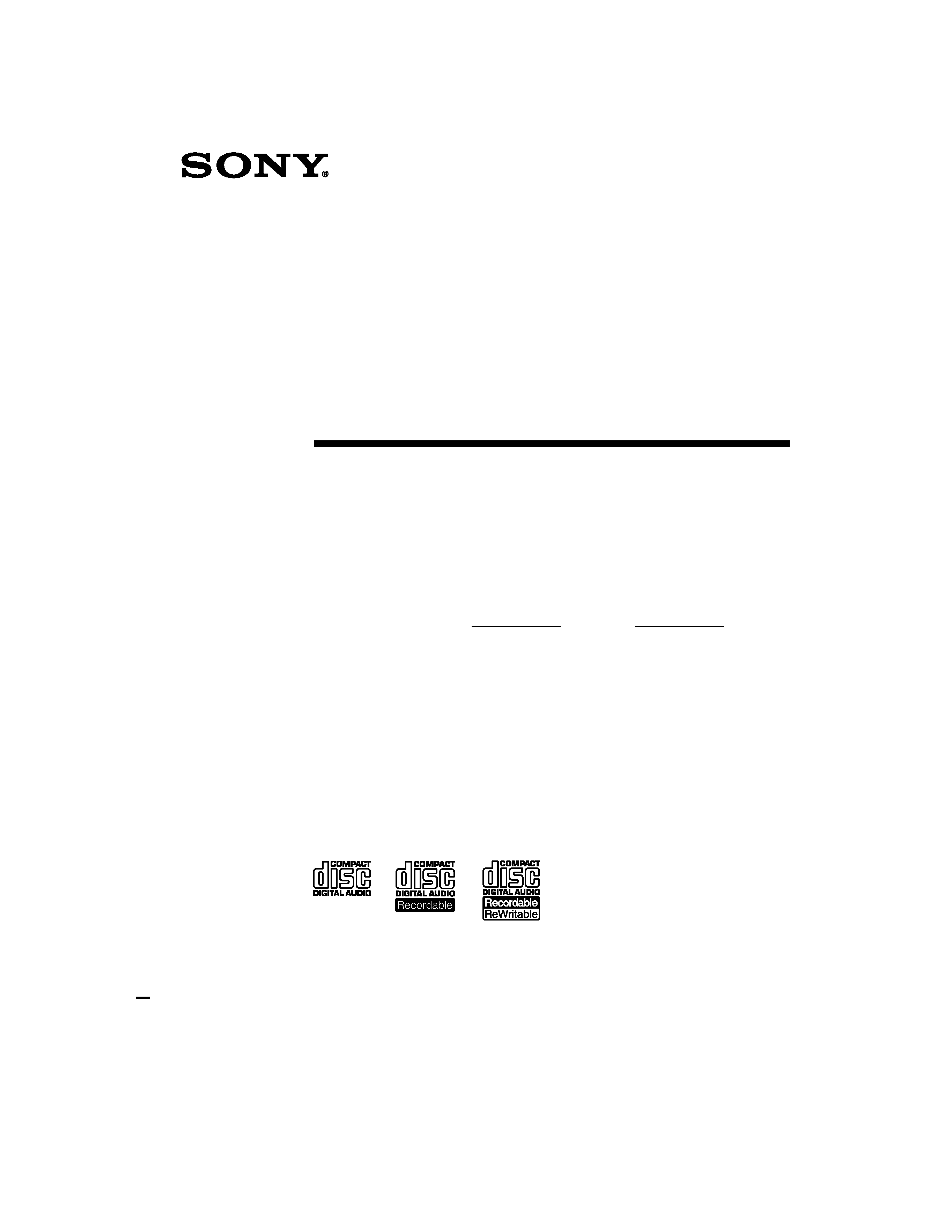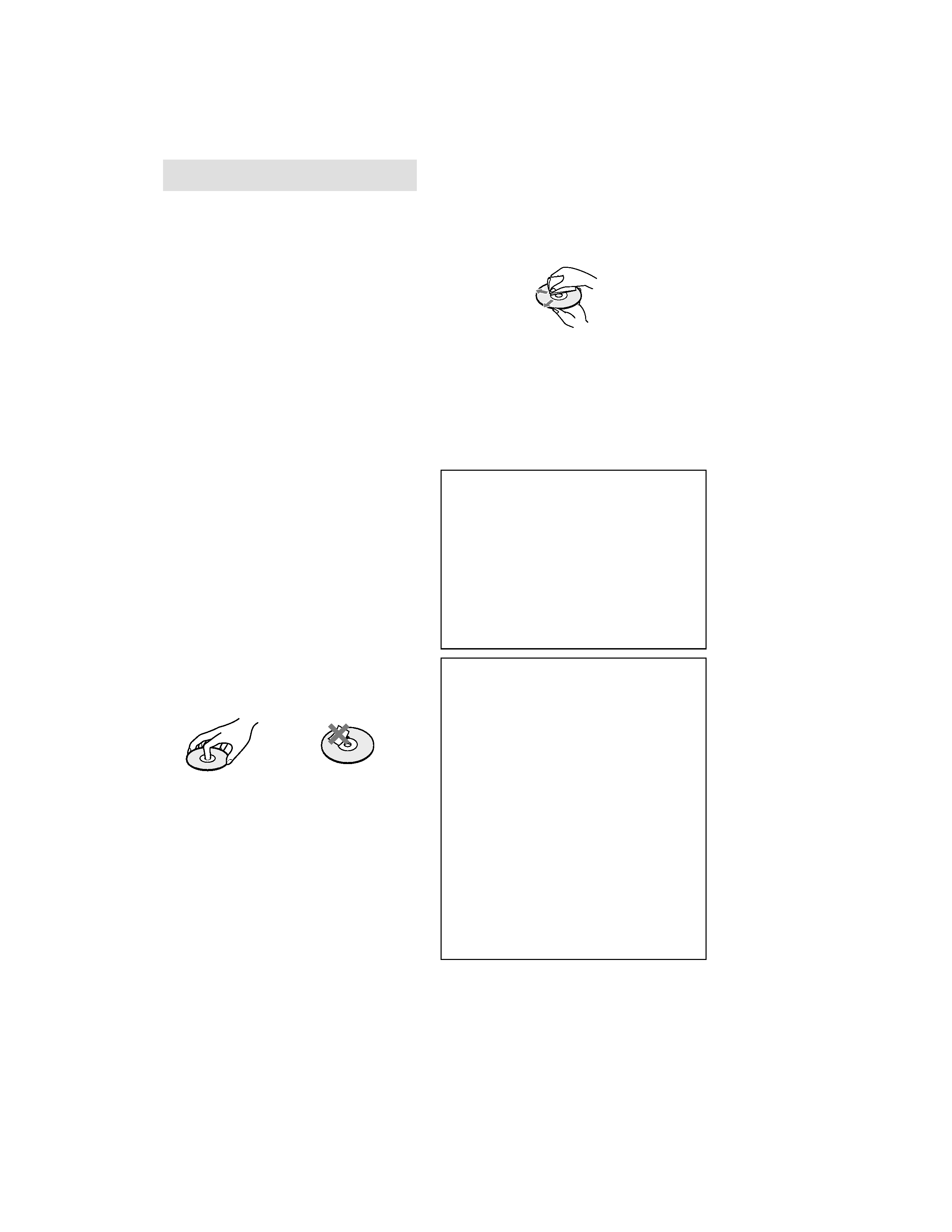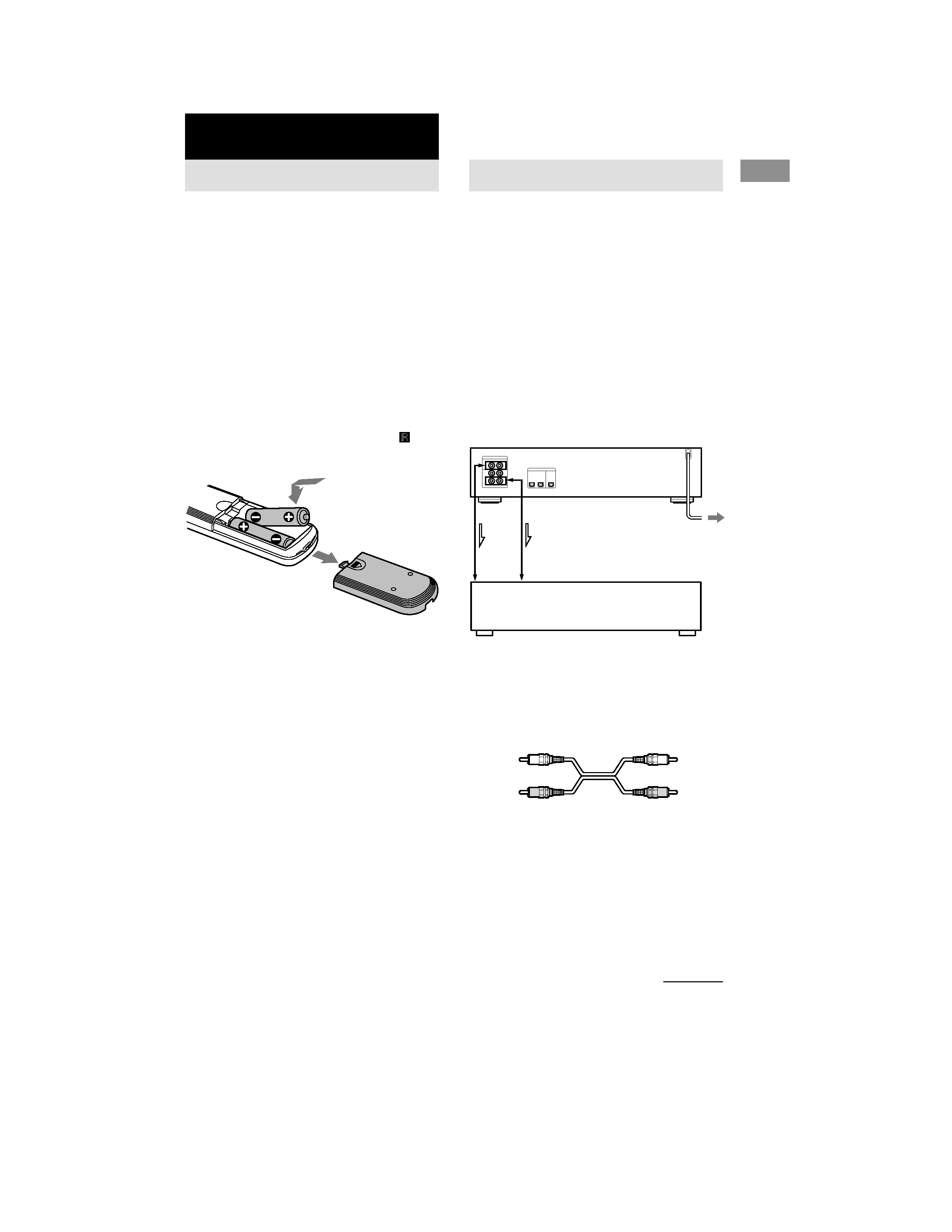
RCD-W1 (US) 4-233-692-12(1)
Actual page number:
©2001 Sony Corporation
Operating Instructions
Owner's Record
The model and serial numbers are located on the rear panel. Record the serial number
in the space provided below. Refer to them whenever you call upon your Sony dealer
regarding this product.
Model No.
Serial No.
4-233-692-12(1)
Compact Disc
Recorder
RCD-W1
01COV_RCD-W1.p65
00.12.13, 10:32 AM
1

2
RCD-W1 (US) 4-233-692-12(1)
Actual page number:
WARNING
To prevent fire or shock hazard, do not
expose the unit to rain or moisture.
To avoid electrical shock, do not open
the cabinet. Refer servicing to qualified
personnel only.
The laser component in this product is capable of
emitting radiation exceeding the limit for Class 1.
CAUTION
You are cautioned that any changes or modification
not expressly approved in this manual could void
your authority to operate this equipment.
INFORMATION
This equipment has been tested and found to comply
with the limits for a Class B digital device, pursuant
to Part 15 of the FCC Rules. These limits are
designed to provide reasonable protection against
harmful interference in a residential installation. This
equipment generates, uses, and can radiate radio
frequency energy and, if not installed and used in
accordance with the instructions, may cause harmful
interference to radio communications. However, there
is no guarantee that interference will not occur in a
particular installation. If this equipment does cause
harmful interference to radio or television reception,
which can be determined by turning the equipment
off and on, the user is encouraged to try to correct the
interference by one or more of the following
measures:
Reorient or relocate the receiving antenna.
Increase the separation between the equipment and
receiver.
Connect the equipment into an outlet on a circuit
different from that to which the receiver is
connected.
Consult the dealer or an experienced radio/TV
technician for help.
NOTICE FOR THE CUSTOMERS IN
CANADA
CAUTION:
TO PREVENT ELECTRIC SHOCK, DO NOT USE
THIS POLARIZED AC PLUG WITH AN
EXTENSION CORD, RECEPTACLE OR OTHER
OUTLET UNLESS THE BLADES CAN BE FULLY
INSERTED TO PREVENT BLADE EXPOSURE.
Welcome
Thank you for purchasing the Sony Compact
Disc Recorder. Before operating the recorder,
please read this manual thoroughly and retain it
for future reference.
IN NO EVENT SHALL SELLER BE
LIABLE FOR ANY DIRECT, INCIDENTAL
OR CONSEQUENTIAL DAMAGES OF
ANY NATURE, OR LOSSES OR
EXPENSES RESULTING FROM ANY
DEFECTIVE PRODUCT OR THE USE OF
ANY PRODUCT
This symbol is intended to alert the
user to the presence of uninsulated
"dangerous voltage" within the
product's enclosure that may be of
sufficient magnitude to constitute a risk
of electric shock to persons.
This symbol is intended to alert the
user to the presence of important
operating and maintenance (servicing)
instructions in the literature
accompanying the appliance.
For the customers in the U.S.A.
02REG_RCD-W1.p65
00.12.13, 10:32 AM
2

3
ES
F
P
RCD-W1 (US) 4-233-692-12(1)
Actual page number:
Precautions
On safety
· Should any solid object or liquid fall into the
cabinet, unplug the recorder and have it checked
by qualified personnel before operating it any
further.
· The use of optical instruments with this product
will increase the risk of eye hazard.
On power sources
· Before operating the recorder, check that the
operating voltage of the deck is identical with your
local power supply. The operating voltage is
indicated on the nameplate at the rear of the
recorder.
· The unit is not disconnected from the AC power
source (mains) as long as it is connected to the wall
outlet, even if the unit itself has been turned off.
· If you are not going to use the recorder for a long
time, be sure to disconnect the recorder from the
wall outlet. To disconnect the AC power cord,
grasp the plug itself; never pull the cord.
· AC power cord must be changed only at a
qualified service shop.
On condensation in the recorder
If the recorder is brought directly from a cold to a
warm location, or is placed in a very damp room,
moisture may condense on the lenses inside the
recorder. Should this occur, the recorder may not
operate properly. In this case, remove the CD, CD-R,
or CD-RW and leave the recorder turned on for about
an hour until the moisture evaporates.
On handling Discs
· To keep the disc clean, handle it by its edge. Do
not touch the surface.
· Do not stick adhesive papers or tapes onto the disc.
On cleaning
· Fingerprints or dust on the disc may cause poor
sound reproduction or sound dropout.
· Before playing a disc, clean it with a cleaning
cloth. Wipe the disc from the center out.
· If the disc is still dirty after being wiped with a
cleaning cloth, wipe it again with a slightly
moistened cloth. Then wipe off the residual
moisture with a dry cloth.
· Do not use solvents such as benzene, thinner,
commercially available cleaners, or antistatic
spray intended for vinyl LPs.
Note on High-Speed CD to
CD-R or CD-RW Synchro-
Recording
Certain CD conditions may cause sound dropout
or noise in the recording results, or even create
unwanted tracks on the CD-R or CD-RW. If this
happens, clean the CD as instructed in "On
cleaning" above, and record material to the CD-
R or CD-RW using normal-speed CD to CD-R or
CD-RW Synchro-Recording only.
Note on CD-R or CD-RW
playback
When you playback a CD-R or CD-RW
recorded by a CD-R or CD-RW recorder, you
may not be able to playback, depending on the
recording conditions (e.g., dirty disc, etc.).
Also, you should note that you need to finalize
a CD-R or CD-RW before playing back on
another system other than the one used to make
the recording. (Finalizing is a process to
complete the recording.)
After finalizing a CD-R disc, you can play it in
any conventional CD player. However,
depending on the state of the recording, there
may be sound skips during playback.
After finalizing a CD-RW disc, you can play it
in a CD-RW compatible player only.
· Only regular circular discs can be used in this
recorder. Irregularly shaped discs, such as star- or
heart-shaped discs may damage the recorder.
· If there is glue or a similar substance on the disc,
remove it completely before using the disc.
On storage
· Do not expose the disc to direct sunlight or heat
sources such as hot air ducts, nor leave it in a car
parked in direct sunlight as there can be a
considerable rise in temperature inside the car.
· Store discs in their cases. Do not store discs either
stacked horizontally or standing vertically without
their cases.
02REG_RCD-W1.p65
00.12.13, 10:32 AM
3

4
RCD-W1 (US) 4-233-692-12(1)
Actual page number:
Contents
Getting Started
Unpacking ............................................. 5
Hooking Up the System ........................ 5
This Recorder Can Use the Following
Discs ................................................ 6
Basic Operations
Playing a CD ......................................... 7
Using the display ................................... 8
Locating a Specific Track .................... 10
Locating a Particular Point
in a Track ...................................... 11
Playing Tracks Repeatedly
(Repeat Play) ................................. 11
Playing in Random Order
(Shuffle Play) ................................ 12
Creating Your Own Program
(Program Play) .............................. 12
Alternating Discs from One Tray
to the Other (Relay Play) ............... 13
Playing Both Deck Simultaneously
(Dual Play) .................................... 14
Recording on CDR
Recording a CD to CD-R or
CD-RW disc .................................. 15
Recording a CD to CD-R or
CD-RW disc at High Speed .......... 16
Recording on a CD-R or
CD-RW disc Manually .................. 18
Finalizing a CD-R or CD-RW disc ..... 20
Unfinalizing a CD-RW disc ............... 21
Erasing a single track of
CD-RW disc .................................. 22
Erasing an Entire CD-RW disc ........... 23
Additional Information
Error Messages .................................... 24
System Limitations .............................. 24
Troubleshooting ................................... 25
Specifications ...................................... 26
03TOC_RCD-W1.p65
00.12.13, 10:32 AM
4

5
Getting
Started
Started
RCD-W1 (US) 4-233-692-12(1)
Actual page number:
Unpacking
Check that you received the following items:
· Audio connecting cord (2)
· Remote commander (remote) (1)
· Size AA (R6) batteries (2).
Inserting batteries into the
remote
You can control the recorder using the supplied
remote.
Insert two size AA (R6) batteries by matching
the 3 and # ends on the batteries to the
markings inside the compartment. When using
the remote, point it at the remote sensor
on
the recorder.
Getting Started
Tip
With normal use, the batteries should last for about
six months. When the remote no longer operates the
recorder, replace all the batteries with new ones.
Notes
· Do not leave the remote near an extremely hot or
humid place.
· Do not drop any foreign object into the remote
casing, particularly when replacing the batteries.
· Do not expose the remote sensor to direct light from
the sun or lighting apparatus. Doing so may cause a
malfunction.
· If you don't use the remote for an extended period
of time, remove the batteries to avoid possible
damage from battery leakage and corrosion.
TAPE/MD IN
Amplifier
CD IN
Hooking Up the System
Overview
This section describes how to hook up the CD
recorder to an amplifier. Be sure to turn off the
power of each component before making the
connections.
Use the audio connecting cord (supplied) (2).
When you turn off the Relay Play (page 13),
you can play both DECK A and DECK B (page
14 "Dual Play"), and you can output the sound
from CD OUT and CD-R OUT at the same
time.
The cord you need to hook up your
recorder
· Audio connecting cords (supplied) (2)
Red
(R)
White
(L)
White
(L)
Red
(R)
l
l
l
l
l: Signal flow
continued
RCD-W1
04GET_RCD-W1.p65
00.12.13, 10:32 AM
5
